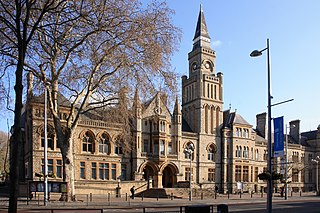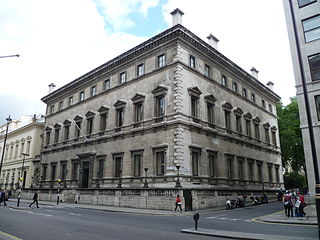Isabella Matilda Holmes (1861-1949) was a notable Victorian social campaigner and an advocate of opening up London's green spaces to the poor. [1]
Contents

Isabella Matilda Holmes (1861-1949) was a notable Victorian social campaigner and an advocate of opening up London's green spaces to the poor. [1]

Holmes was an authority on the graveyards and parks of London. Intrepid and doughty, [2] she chronicled every cemetery in the Capital - often at significant personal risk. [3] Published in 1896, her book 'London Burial Grounds: Notes on their History from Earliest Times to the Present Day', remains central to understanding of the development of the capital's burial sites. She became Honorary Secretary of the Metropolitan Public Gardens Association, and her employment as scout for the Association was key to the organisation's success. [4] Were it not for her work, much that we know about London's burial grounds and open spaces would have been lost. [5]
Born in Kensington, Holmes was the daughter of chemist Dr John Hall Gladstone. In 1887, she married Basil Holmes, a local politician in Ealing, west London, and Secretary of the Metropolitan Public Gardens Association. [6] They lived in Ealing, and had five children, Edith, Marion, Wilfred, Stephen, and Edward. The family attended St Peter's Church, Ealing, where Basil Holmes was a sidesman. [7] Stephen Holmes became High Commissioner for Australia from 1952 to 1956. Wilfred Gladstone Holmes died in 1913 while serving as a Second Lieutenant in the Royal Garrison Artillery. He is memorialised in St Peter's Church, Ealing, where the Lady Chapel altar rails were given in his memory, [8] as well as at Bradfield College. [9] Isabella Holmes' half sister Margaret Ethel Gladstone became the wife of Ramsay MacDonald, Britain's first Labour Prime Minister. [10]
A short film on Isabella Holmes and London's burial grounds - London History: Destruction of the Dead.
A blog on Isabella Holmes London Graveyards and the Wonderful Mrs Basil Holmes

Philip St. John Basil Rathbone MC was an Anglo-South African actor. He rose to prominence in the United Kingdom as a Shakespearean stage actor and went on to appear in more than 70 films, primarily costume dramas, swashbucklers, and, occasionally, horror films.

Ealing is a district in West London, England, 7.5 miles (12.1 km) west of Charing Cross in the London Borough of Ealing. It is the administrative centre of the borough and is identified as a major metropolitan centre in the London Plan.

Bunhill Fields is a former burial ground in central London, in the London Borough of Islington, just north of the City of London. What remains is about 1.6 hectares in extent and the bulk of the site is a public garden maintained by the City of London Corporation.

Kensal Green Cemetery is a cemetery in the Kensal Green area of North Kensington in the Royal Borough of Kensington and Chelsea and the London Borough of Hammersmith and Fulham in London, England. Inspired by Père Lachaise Cemetery in Paris, it was founded by the barrister George Frederick Carden. The cemetery opened in 1833 and comprises 72 acres (29 ha) of grounds, including two conservation areas, adjoining a canal. The cemetery is home to at least 33 species of bird and other wildlife. This distinctive cemetery has memorials ranging from large mausoleums housing the rich and famous to many distinctive smaller graves and includes special areas dedicated to the very young. It has three chapels and serves all faiths. It is one of the Magnificent Seven cemeteries in London.

The Reform Club is a private members' club, owned and controlled by its members, on the south side of Pall Mall in central London, England. As with all of London's original gentlemen's clubs, it had an all-male membership for decades, but it was one of the first all-male clubs to change its rules to include the admission of women on equal terms in 1981. Since its foundation in 1836, the Reform Club has been the traditional home for those committed to progressive political ideas, with its membership initially consisting of Radicals and Whigs. However, it is no longer associated with any particular political party, and it now serves a purely social function.

The London Necropolis Company (LNC), formally the London Necropolis & National Mausoleum Company until 1927, was a cemetery operator established by Act of Parliament in 1852 in reaction to the crisis caused by the closure of London's graveyards in 1851. The LNC intended to establish a single cemetery large enough to accommodate all of London's future burials in perpetuity. The company's founders recognised that the recently invented technology of the railway provided the ability to conduct burials far from populated areas, mitigating concerns over public health risks from living near burial sites. Accordingly, the company bought a very large tract of land in Brookwood, Surrey, around 25 miles (40 km) from London, and converted a portion of it into Brookwood Cemetery. A dedicated railway line, the London Necropolis Railway, linked the new cemetery to the city.

Brookwood Cemetery, also known as the London Necropolis, is a burial ground in Brookwood, Surrey, England. It is the largest cemetery in the United Kingdom and one of the largest in Europe. The cemetery is listed a Grade I site in the Register of Historic Parks and Gardens.

West Norwood Cemetery is a 40-acre (16 ha) rural cemetery in West Norwood in London, England. It was also known as the South Metropolitan Cemetery. One of the first private landscaped cemeteries in London, it is one of the "Magnificent Seven" cemeteries of London, and is a site of major historical, architectural and ecological interest.

The Magnificent Seven is an informal term applied to seven large private cemeteries in London. These are Kensal Green Cemetery, West Norwood Cemetery, Highgate Cemetery, Abney Park Cemetery, Brompton Cemetery, Nunhead Cemetery, and Tower Hamlets Cemetery. They were established in the 19th century to alleviate overcrowding in existing parish burial grounds as London’s population grew during the Victorian era. In 1981, the architectural historian Hugh Meller dubbed the group of cemeteries "The Magnificent Seven" after the 1960 western film of the same name.

London Necropolis railway station was the terminus at Waterloo, London, of the London Necropolis Railway. The London Necropolis Railway was opened in 1854 as a reaction to severe overcrowding in London's existing graveyards and cemeteries. It aimed to use the recently developed technology of the railway to move as many burials as possible to the newly built Brookwood Cemetery in Brookwood, Surrey. This location was within easy travelling distance of London, but distant enough for the dead not to pose any risk to public hygiene. There were two locations for the station; the first was in operation from 1854 to 1902, the second from 1902 to 1941.

The Glasgow Necropolis is a Victorian cemetery in Glasgow, Scotland. It is on a low but very prominent hill to the east of Glasgow Cathedral. Fifty thousand individuals have been buried here. Typical for the period, only a small percentage are named on monuments and not every grave has a stone. Approximately 3,500 monuments exist here.

Hubberholme is an old village in Upper Wharfedale in the Yorkshire Dales, North Yorkshire, England, at the point where Langstrothdale meets Wharfedale. It is quite secluded and the nearest village is Buckden.

Postman's Park is a public garden in central London, a short distance north of St Paul's Cathedral. Bordered by Little Britain, Aldersgate Street, St. Martin's Le Grand, King Edward Street, and the site of the former headquarters of the General Post Office (GPO), it is one of the largest open spaces in the City of London.

John Hall Gladstone FRS was a British chemist. He served as President of the Physical Society between 1874 and 1876 and during 1877–1879 was President of the Chemical Society. Apart from chemistry, where one of his most notable publications was on bromination of rubber, he undertook pioneering work in optics and spectroscopy.
Events from the year 1893 in the United Kingdom.

Margaret Ethel MacDonald was a British feminist, social reformer, and wife of Labour politician Ramsay MacDonald from 1896 until her death from blood poisoning in 1911.

The London Necropolis Railway was a railway line opened in November 1854 by the London Necropolis Company (LNC), to carry corpses and mourners between London and the LNC's newly opened Brookwood Cemetery, 23 miles (37 km) southwest of London in Brookwood, Surrey. At the time the largest cemetery in the world, Brookwood Cemetery was designed to be large enough to accommodate all the deaths in London for centuries to come, and the LNC hoped to gain a monopoly on London's burial industry. The cemetery had intentionally been built far enough from London so as never to be affected by urban growth and was dependent on the recently invented railway to connect it to the city.

St Peter's Church, Ealing, is an Anglican parish church in Mount Park Road, North Ealing, in the Diocese of London, regarded by Sir John Betjeman a church "of which we can justafiably be proud. Held to be one of the premier architectural works in Ealing, the Grade II* Listed building is noted for its combination of Arts & Crafts and late-Victorian Gothic as well as its west front and great west window. In addition to Sunday and weekday services, the church and adjacent hall serve as a hub for various community activities and events.

Quaker Gardens is a small public garden in the extreme south of the London Borough of Islington, close to the boundary with the City of London, in the area known historically as Bunhill Fields. It is managed by Islington Borough Council. It comprises the surviving fragment of a former burying ground for Quakers, in use from 1661 to 1855. George Fox, one of the founders of the movement, was among those buried here.
Stephen Ronald Jakobi OBE is an English writer and human rights lawyer who is a former chief executive of Fair Trials Abroad, which he founded in 1992.